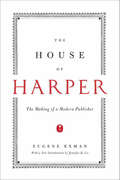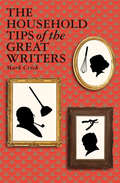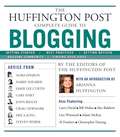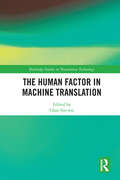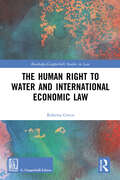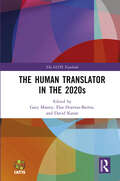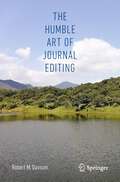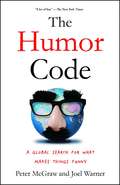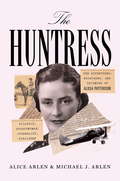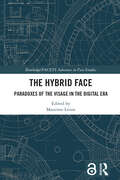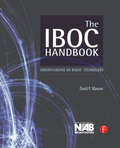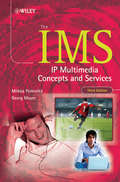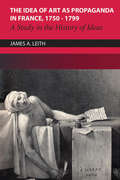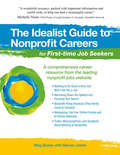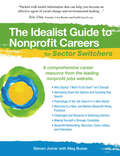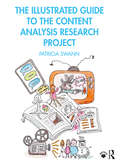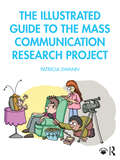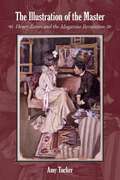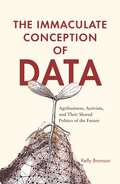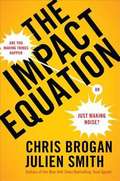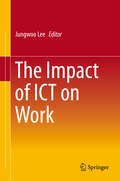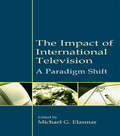- Table View
- List View
The House of Harper: The Making of a Modern Publisher
by Eugene ExmanAn updated edition of this definitive history of Harper—a fascinating look into the history of American letters from the unique perspective of one of the country’s most distinguished and enduring publishers—now with a new introduction that brings the book up to the present day. From Moby Dick to Huckleberry Finn—but not Alice in Wonderland, which was rejected—The House of Harper is a sweeping trip through American letters, offering anecdotes and stories about authors from Charles Dickens, Herman Melville, and Mark Twain to Thomas Wolfe, Aldous Huxley, and Edna St. Vincent Millay.
The Household Tips of the Great Writers
by Mark CrickWhat would literary lions tell us about cooking, cleaning, and gardening? A three-book collection of parody and practical advice by a &“brilliant&” humorist (The Financial Times). The Household Tips of Great Writers covers all your household needs, indoors and outdoors, from pruning a rose bush with Pablo Neruda to mending a dripping tap with Jean-Paul Sartre. Throwing a tea party? Irvine Welsh has the recipe for the perfect chocolate cake, though that's not all he's cooking. Brilliant, hilarious, and always pitch-perfect, this omnibus edition of Mark Crick's wonderful books of literary pastiche will inform and entertain the most erudite of householders. Includes: Sartre&’s Sink &“This brilliantly inventive DIY manual both parodies and celebrates great authors ... Crick is a brilliant literary ventriloquist.&”—The Financial Times Kafka&’s Soup &“These literary and visual pastiches of writers and their relationships with food provide a laugh a line as they skewer their literary originals with effortless accuracy...a masterpiece.&”—The Guardian Machiavelli&’s Lawn &“Erudite and enjoyable prose, no less rewarding for its horticultural accuracy.&”—Times Literary Supplement
The Hroswitha Club and the Impact of Women Book Collectors (Elements in Publishing and Book Culture)
by Kate OzmentThe Hroswitha Club was a group of women book collectors who met from 1944–2004 in the Eastern United States. Despite the fame of individual members like Henrietta Bartlett or Mary Hyde Eccles, there is no sustained study of the Club's work and legacy. This Element makes this history broadly accessible and focuses on how members shared knowledge and expertise and provided a space for legitimacy and self-growth in a period where women's access to formal education and academic institutions was limited. By making this network visible through an examination of archival records, library catalogs, and pamphlets, this project positions the Club as a case study for a more thorough examination of the ways that intersectional identities can make visible or obscure whose intellect, money, and resources have shaped the study of rare books in the United States.
The Huffington Post Complete Guide to Blogging
by Arianna Huffington The editors of the Huffington PostThe editors of The Huffington Post -- the most linked-to blog on the web -- offer an A-Z guide to all things blog, with information for everyone from the tech-challenged newbie looking to get a handle on this new way of communicating to the experienced blogger looking to break through the clutter of the Internet. With an introduction by Arianna Huffington, the site's cofounder and editor in chief, this book is everything you want to know about blogging, but didn't know who to ask. As entertaining as it is informative, The Huffington Post Complete Guide to Blogging will show you what to do to get your blog started. You'll find tools to help you build your blog, strategies to create your community, tips on finding your voice, and entertaining anecdotes from HuffPost bloggers that will make you wonder what took you so long to blog in the first place. The Guide also includes choice selections from HuffPost's wide-ranging mix of top-notch bloggers. Among those who have blogged on HuffPost are Barack Obama, Hillary Clinton, Larry David, Jane Smiley, Bill Maher, Nora Ephron, Jon Robin Baitz, Steve Martin, Lawrence O'Donnell, Ari Emanuel, Mia Farrow, Al Franken, Gary Hart, Barbara Ehrenreich, Edward Kennedy, Harry Shearer, Nancy Pelosi, Adam McKay, John Ridley, and Alec Baldwin.
The Human Factor in Machine Translation (Routledge Studies in Translation Technology)
by Sin-Wai ChanMachine translation has become increasingly popular, especially with the introduction of neural machine translation in major online translation systems. However, despite the rapid advances in machine translation, the role of a human translator remains crucial. As illustrated by the chapters in this book, man-machine interaction is essential in machine translation, localisation, terminology management, and crowdsourcing translation. In fact, the importance of a human translator before, during, and after machine processing, cannot be overemphasised as human intervention is the best way to ensure the translation quality of machine translation. This volume explores the role of a human translator in machine translation from various perspectives, affording a comprehensive look at this topical research area. This book is essential reading for anyone involved in translation studies, machine translation or interested in translation technology.
The Human Right to Water and International Economic Law (Routledge-Giappichelli Studies in Law)
by Roberta GrecoThis book discusses the international right to water and the liberalization of water services. It is concerned with the harmonization of the right to water with the legal systems under which liberalization of water services has taken or may take place. It assesses paths of harmonization between international human rights law and international economic law in this specific field. The issue of the compatibility between the fulfilment of the right to water and the liberalization of water services has been at the heart of a passionate public debate between opponents and advocates of the privatization of the utility. The book provides an unbiased analysis of different international legal regimes under which the liberalization of water services has occurred or is likely to occur, notably international investment law, international trade law and European Union law, in order to assess whether the main features of the right to water can be guaranteed under each of these systems of law and whether there is space for prospective harmonization. The work will be an invaluable resource for academics, researchers and policy-makers working in the areas of International Human Rights Law, International Economic Law, International Water Law, International Trade Law and EU Law.
The Human Translator in the 2020s (The IATIS Yearbook)
by Gary Massey David Katan Elsa Huertas-BarrosHas the language industry of the 21st century been racing ahead of the translation profession and leaving translators behind? Or are translators adapting to new sociotechnical realities and societal demands, and if so, how? The chapters in this volume seek to shed light on the profiles and position of human translators in the current decade. This collection draws together the work of leading authors to reflect on the constantly evolving language industry. The eight chapters present new perspectives on, and concepts of, translation in a digital world. They highlight the shifts taking place in the sociotechnical environment of translation and the need to address changing buyer needs and market demands with new services, profiles and training. In doing so, they share a common focus on the added value that human translators can and do bring to bear as adaptive, creative, digitally literate experts. Addressing an international readership, this volume is of interest to advanced students and researchers in translation and interpreting studies, and professionals in the global language industry.
The Humble Art of Journal Editing
by Robert M. DavisonThe publication of scholarly research is both a major driver of social progress and a significant industry in its own right. Scholarly research is the focus of attention for countless numbers of scholars globally and a key measure of scholarly excellence. Much has been written about the conduct of research that is designed to help scholars attain appropriate standards of rigor and relevance, and indeed craft their research outputs in ways appropriate for different venues, notably as journal articles, conference papers, book chapters, and books. However, although scholarly researchers fulfill roles other than as authors, for instance as journal reviewers and editors, there is a dearth of consolidated information about the nature of editorial work. Drawing on over two decades of experience in editing scholarly journals, the author offers a more systematic guide to scholarly journal editing.The book begins with an introduction to the art of scholarly journal editing,the nature of that art (Chapter 1), and an examination of editorial promulgation of cultural values of scholarly journals with an emphasis on responsible research (Chapter 2). Chapter 3 examines the many issues associated with sourcing content, and opines on the novelty, breadth, and depth of research, including discussions of indigenous theorization, serendipity, iconoclastic research, and the value of special issues. Chapter 4 deals with the review process and offers advice for formulating effective reviewer guidelines that lead to constructive and developmental advice for authors. The next two chapters discuss the audience of the journal as well as publisher relations. Finally, the book is concluded with thoughts and recommendations about emerging challenges, such as the ethics of AI tools (like ChatGPT), predatory journals, and the open-access movement.Offering a practical guide to editing scholarly journals, this book will be a key resource for scholars making the leap from researcher to editor, regardless of discipline.
The Humor Code: A Global Search for What Makes Things Funny
by Joel Warner Peter McGrawPart road-trip comedy and part social science experiment, a scientist and a journalist “shed fascinating light on what makes us laugh and why” (New York Post).Two guys. Nineteen experiments. Five continents. 91,000 miles. The Humor Code follows the madcap adventures and oddball experiments of Professor Peter McGraw and writer Joel Warner as they discover the secret behind what makes things funny. In their search, they interview countless comics, from Doug Stanhope to Louis CK and travel across the globe from Norway to New York, from Palestine to the Amazon. It’s an epic quest, both brainy and harebrained, that culminates at the world’s largest comedy festival where the pair put their hard-earned knowledge to the test. For the first time, they have established a comprehensive theory that answers the question “what makes things funny?” Based on original research from the Humor Research Lab (HuRL) at the University of Colorado, Boulder, and the pair’s experiences across the globe, The Humor Code explains the secret behind winning the New Yorker cartoon caption contest, why some dead baby jokes are funnier than others, and whether laughter really is the best medicine. Hilarious, surprising, and sometimes even touching, The Humor Code “lays out a convincing theory about how humor works, and why it’s an essential survival mechanism” (Mother Jones).
The Hungover Games: A True Story
by Sophie HeawoodThis "funny, dark, and true" (Caitlin Moran) memoir is Bridget Jones's Diary for the Fleabag generation: What happens when you have an unplanned baby on your own in your mid-thirties before you've worked out how to look after yourself, let alone a child?This is the story of one woman's adventures in single motherhood. It's about what happens when Mr. Right isn't around so you have a baby with Mr. Wrong, a touring musician who tells you halfway through your pregnancy that he's met someone else, just after you've given up your LA life and moved back to England to attempt some kind of modern family life with him.So now you're six months along, sleeping on a friend's sofa in London, and waking up in the morning to a room full of taxidermied animals who seem to be staring at you. The Hungover Games about what it's like raising a baby on your own when you're more at home on the dance floor than in the kitchen. It's about how to invent the concept of the two-person family when you grew up in a traditional nuclear unit of four, and your kid's friends all have happily married parents too, and you are definitely not, in any way, ticking off the days until all those lovely couples get divorced.Unflinchingly honest, emotionally raw, and surprisingly sweet, The Hungover Games is the true story of what happens if you've been looking for love your whole life and finally find it where you least expect it.
The Huntress: Aviatrix, Sportswoman, Journalist, Publisher
by Michael J. Arlen Alice ArlenThe fascinating biography of the maverick newspaperwoman and intrepid adventurer, which follows her exceptional exploits through the first half of the twentieth century, from her troublemaking days as the middle child of complicated parents to her successes as publisher of the Pulitzer Prize-winning Newsday. The authors take us into the lost WASP world of Alicia Patterson: her larger-than-life father--scion of the Patterson-Medill Chicago publishing dynasty--and her traditional mother, her childhood of foreign caretakers, travel, and boarding schools. Married off at twenty-three to a friend of her father's, Alicia spent little time at home during the brief marriage, instead earned a transport pilot's license (only the tenth woman in the country to do so), hunted big game in Indochina and India; and began to write for her father's newspaper The Daily News. Her second father-orchestrated marriage failed, but her last, to someone of her own choosing, Harry Guggenheim, resulted in the founding of Newsday in 1940. As she guided the paper through investigative exposés and international and liberal political coverage, her influence on the national stage grew along with the newspaper's reputation and circulation: winning a Pulitzer in 1954 and putting her on the cover of Time. Over the years admirers ranged from the Maharajah of Baroda to Adlai Stevenson. Here is the story of the spirited and formidable young woman who became a preeminent figure of the golden era of print newspapers.(With black-and-white illustrations throughout)From the Hardcover edition.
The Hybrid Face: Paradoxes of the Visage in the Digital Era (Routledge/FACETS Advances in Face Studies)
by Massimo LeoneThis original and interdisciplinary volume explores the contemporary semiotic dimensions of the face from both scientific and sociocultural perspectives, putting forward several traditions, aspects, and signs of the human utopia of creating a hybrid face. The book semiotically delves into the multifaceted realm of the digital face, exploring its biological and social functions, the concept of masks, the impact of COVID-19, AI systems, digital portraiture, symbolic faces in films, viral communication, alien depictions, personhood in video games, online intimacy, and digital memorials. The human face is increasingly living a life that is not only that of the biological body but also that of its digital avatar, spread through a myriad of new channels and transformable through filters, post-productions, digital cosmetics, all the way to the creation of deepfakes. The digital face expresses new and largely unknown meanings, which this book explores and analyzes through an interdisciplinary but systematic approach. The volume will interest researchers, scholars, and advanced students who are interested in digital humanities, communication studies, semiotics, visual studies, visual anthropology, cultural studies, and, broadly speaking, innovative approaches about the meaning of the face in present-day digital societies.
The Hype Machine: How Social Media Disrupts Our Elections, Our Economy, and Our Health--and How We Must Adapt
by Sinan AralA landmark insider&’s tour of how social media affects our decision-making and shapes our world in ways both useful and dangerous, with critical ideas on how to protect ourselves in the 2020 election and beyond &“The most important book of the year . . . a lively, engaging masterpiece.&”—Erik Brynjolfsson, bestselling co-author of The Second Machine AgeMIT professor Sinan Aral isn&’t only one of the world&’s leading experts on social media—he&’s also an entrepreneur and investor, giving him an unparalleled 360-degree view of the technology&’s great promise as well as its outsize capacity to damage our politics, our economy, and even our personal health. Drawing on two decades of his own research and business experience, Aral goes under the hood of the biggest, most powerful social networks to tackle the critical question of just how much social media actually shapes our choices, for better or worse. Aral shows how the tech behind social media offers the same set of behavior-influencing levers to both Russian hackers and brand marketers—to everyone who hopes to change the way we think and act—which is why its consequences affect everything from elections to business, dating to health. Along the way, he covers a wide array of topics, including how network effects fuel Twitter&’s and Facebook&’s massive growth to the neuroscience of how social media affects our brains, the real consequences of fake news, the power of social ratings, and the impact of social media on our kids.In mapping out strategies for being more thoughtful consumers of social media, The Hype Machine offers the definitive guide to understanding and harnessing for good the technology that has redefined our world overnight.
The IBOC Handbook: Understanding HD Radio (TM) Technology
by David P. MaxsonRadio broadcast engineers seeking to design and operate HD Radio(TM) transmission systems will benefit from the detailed exposition of the technology. The book lays out the entire structure of this digital transmission system. System equations are presented in a manner that is useful to those interested in them, while retaining a clear narrative for those who seek a general understanding of how the technology works. The book also presents a summary of the history of the technology and the NRSC-5 standard, as well as forward-looking information on emerging technologies and applications.
The IMS
by Georg Mayer Miikka PoikselkäThe 3rd edition of this highly successful text builds on the achievement of the first two editions to provide comprehensive coverage of IMS. It continues to explore the concepts, architecture, protocols and functionalities of IMS while providing a wealth of new and updated information. It is written in a manner that allows readers to choose the level of knowledge and understanding they need to gain about the IMS.With 35% new material, The IMS,IP Multimedia Concepts and Services, 3rd Edition has been completely revised to include updated chapters as well as totally new chapters on IMS multimedia telephony and IMS voice call continuity. Additional new material includes IMS transit, IMS local numbering, emergency sessions, identification of communication services in IMS, new authentication model for fixed access, NAT traversal and globally routable user agents URI. Detailed descriptions of protocol behaviour are provided on a level that can be used for implementation and testing.Key features of the 3rd edition:Two new chapters on IMS multimedia telephony service and IMS Voice Call ContinuityUpdated information on Third Generation Partnership Project (3GPP) Release 7 level, including architecture, reference points and conceptsSubstantially extended coverage on IMS detailed proceduresCompletely rewritten and extended chapters on IMS services
The Idea of Art as Propaganda in France, 1750-1799: A Study in the History of Ideas (The Royal Society of Canada Special Publications #No. 8)
by James LeithOne of the most modern features of the French Revolution was its intention of shaping a new kind of citizen by exposing him from childhood to inspirational messages and behavioral models. In this effort to regenerate the masses the French Revolutionaries sought to employ not only schools, but newspapers, festivals, dramas, poems, songs, paintings, statues, and engravings as well. At the peak of the Terror, French leaders brough tthe West to the threshold of the totalitarian state in the fullest sense of the world: they established a single party state, directed a regimented economy, created a mass army, and sought to mobilize all the media capable of influencing the human mind. In was an interest in both art and the Revolution which led Professor Leith to explore the groth of the idea of using art as one instrument of propaganda. The idea proved to have deep roots in western civilization, going back to classical thinkers, medieval churchmen, and the art officials of such monarchs as Louis XIV. But following the hedonistic rococo art of the first half of the eighteenth century, this idea of didactic art took on a new lease of life, reaching a crescendo during the Terror. This book analyses the contribution of the philosophes, the Encyclopedists, royal officials, art critics, and revolutionary leaders to the resurgence of the idea; it also probes the peculiar psychological assumptions which led eighteeneth-century thinkers to believe in the efficacy of visual propaganda. The outcome of this idea of art as an ideological weapon was involved in the fate of the Revolution itself, yet it was also affected by certain curious tensions already evident in the minds of its advocates under the Old Régime. Lingering interest in purely aesthetic values,k affirmation of the need for creative freedom, and determination to maintain French cultural hegemony, all complicated the effort to turn art into a vehicle of civic instruction. The final chapter examines the rôle of these tensions in the dénouement of the idea in the closing phase of the Revolution.This book should appeal not only to those interested in French civilization, the age of Enlightment, and they French Revolution, but to those concerned with the rôle of art and the artist in modern society as well.
The Idealist Guide to Nonprofit Careers for First-time Job Seekers
by Steven Joiner Meg BusseInterested in exploring opportunities for meaningful work in the nonprofit sector?The Idealist Guide to Nonprofit Careers for First-time Job Seekers is a comprehensive resource for emerging professionals pursuing their first position in the nonprofit sector. Whether you are a current student, a recent graduate, or someone entering the workforce for the first time, this book will provide you with indispensable advice, relevant strategies, and nonprofit-specific resources to strengthen your job search. Written by nonprofit career experts, The Idealist Guide is designed to be easily accessible and convenient to read.Topics Include: Why Nonprofit? Mastering a Job Search Self and Career Assessment Networking Strategies Job Search Tools Evaluating Organizational Culture Interviews and First Impressions Negotiating the Best Deal Myths and Facts About Nonprofits Nonprofit Speak 101Written by the staff of Idealist.org with guest sections by other nonprofit experts.Idealist.org is the leading organization in the field of nonprofit careers. Idealist.org runs the website where people and organizations can exchange resources and ideas, locate opportunities and supporters, and take steps to turn their good intentions into action.
The Idealist Guide to Nonprofit Careers for Sector Switchers
by Steven Joiner Meg BusseThe Idealist Guide to Nonprofit Careers for Sector Switchers is the comprehensive resource for transitioning professionals pursuing new career options in the nonprofit sector.Get indispensable advice, relevant strategies, and nonprofit-specific resources to strengthen your job search. Written by nonprofit career experts, The Idealist Guide is easily accessible and convenient to read. If you are a "mid-career transitioner," a "re-careerer," an "encore careerist," a "bridger," or a "sector switcher" this book is meant for you.Topics Include: Why Nonprofit? Myths and Facts About Nonprofits Nonprofit Hiring Practices The Challenge of Sector Switching Self and Career Assessment Networking Strategies Evaluating Organizational Culture Negotiating the Best Deal Starting Your Own Nonprofit Nonprofit Speak 101Written by the staff of Idealist.org with guest sections by other nonprofit experts.Idealist.org is the leading organization in the field of nonprofit careers. Idealist.org runs the website where people and organizations can exchange resources and ideas, locate opportunities and supporters, and take steps to turn their good intentions into action.
The Illustrated Guide to the Content Analysis Research Project
by Patricia SwannThe Illustrated Guide to the Content Analysis Research Project makes mass media research more accessible through an informal and humorous student-centered approach. Author Patricia Swann provides a colorful, step-by-step guide to developing a typical mass media research project using the content analysis method. The fundamental elements of this research method are presented in plainspoken language perfect for undergraduates and new researchers, complete with engaging illustrations and an informal narrative that tackle students’ most common sticking-points when learning and applying research methods. Supplemented by online worksheets for further reflection, this book is an excellent companion to research-centered courses in mass media, communication studies, marketing, and public relations at the introductory level.
The Illustrated Guide to the Mass Communication Research Project
by Patricia SwannThis book makes mass communication research projects more accessible to the new student researcher through a balance between an academically rigorous guide and an informal and humorous student-centered approach. The Illustrated Guide to the Mass Communication Research Project’s unique, visual approach brings to life concepts and tactics under discussion through vivid illustrations. The book follows the universal format of the academic research paper: abstract, introduction, literature review, methodology, hypotheses/research questions, quantitative and qualitative analysis/findings, discussion, and conclusion. It guides the reader through using key methods central to much of mass communication research: observation, interviews, focus groups, case studies, content analysis, surveys, experiments, and sampling. Each chapter contains examples of the segment under discussion, using excerpted research studies that provide writing models for the student’s own research report. Ideal for students in research-centered courses in mass media, communication studies, marketing, and public relations, whether at the undergraduate or graduate level, this text will continue to serve as a valuable resource into a future communications and marketing career. Online resources are provided to support the book: examples of an in-depth interview guide, a focus group moderator guide, a content analysis coding form, observation field notes and an experiment cover story; templates for a personal SWOT analysis and an informed consent form; a research topic worksheet; a literature review matrix; and coding exercises. Please visit www.routledge.com/9781032080758.
The Illustration of the Master: Henry James and the Magazine Revolution
by Amy TuckerIn order to examine the crucial role of the illustrated press in the formation of the reading public and the writing profession during the lifetime of James (1843-1916), Tucker (American literature, City U. of New York-Queens College) rereads a significant portion of his work in light of the explosive growth of the magazine industry in the US and abroad during the period, showing how the rise of the pictorial challenged the primacy of the written text. Her topics include the rise of the illustrated magazine; double discourse in the illustrated tales of the 1890s; his Holbein stepping out of the frame; essays on illustration; and James, Joseph Pennell, and the art of the travelogue. Annotation ©2010 Book News, Inc., Portland, OR (booknews.com)
The Immaculate Conception of Data: Agribusiness, Activists, and Their Shared Politics of the Future
by Kelly BronsonEvery new tractor now contains built-in sensors that collect data and stream it to cloud-based infrastructure. Seed and chemical companies are using these data, and these agribusinesses are a form of big tech alongside firms like Google and Facebook.The Immaculate Conception of Data peeks behind the secretive legal agreements surrounding agricultural big data to trace how it is used and with what consequences. Agribusinesses are among the oldest oligopoly corporations in the world, and their concentration gives them an advantage over other food system actors. Kelly Bronson explores what happens when big data get caught up in pre-existing arrangements of power. Her richly ethnographic account details the work of corporate scientists, farmers using the data, and activist “hackers” building open-source data platforms. Actors working in private and public contexts have divergent views on whom new technology is for, how it should be developed, and what kinds of agriculture it should support. Surprisingly, despite their differences, these groups share a way of speaking about data and its value for the future. Bronson calls this the immaculate conception of data, arguing that this phenomenon is a dangerous framework for imagining big data and what it might do for society.Drawing our attention to agriculture as an important new site for big tech criticism, The Immaculate Conception of Data uniquely bridges science and technology studies, critical data studies, and food studies, bringing to light salient issues related to data justice and a sustainable food system.
The Impact Equation: Are You Making Things Happen or Just Making Noise?
by Chris Brogan Julien SmithChris Brogan and Julien Smith, authors of Trust Agents, are back with The Impact Equation to show you how to make social media pay. What can the IMPACT EQUATION do for you? IMPACT = C × (R+E+A+T+E) Contrast: Does your idea stand out? Reach: How many people do you connect to? Exposure: How often does your audience hear from you? Articulation: Is your idea clear enough? Trust: Do people believe you? Echo: Does your idea connect to your audience? When Chris Brogan and Julien Smith wrote their bestseller Trust Agents, being interesting on the Web was enough to build an audience. Now everybody has a platform. But most of them are just making noise. In The Impact Equation, Brogan and Smith show that to make people truly care about what you have to say, you need more than just a good idea, trust among your audience, or a certain number of followers. You need a potent mix of all of the above - and more. As traditional channels for marketing and selling disappear and more people interact mainly online, the very nature of attention is changing. Use the Impact Equation to figure out what you're doing right and wrong. Apply it to a blog, a tweet, a video, or a mainstream advertising campaign. Use it to explain why a feature in a national newspaper that reaches millions might have less impact than a blog post that reaches a thousand passionate subscribers. The Impact Equation will give you the tools to guarantee your message will be heard. 'Their advice on the importance of being able to write to make a splash online is solid. . . when it comes to building a brand online Brogan and Smith have been there and done that' -The Financial TimesChris Brogan and Julien Smith are consultants and speakers who have worked with Fortune 500 companies, including PepsiCo, General Motors, American Express, and Microsoft. They have been involved in online communities and blogging for more than fifteen years. Their first book, Trust Agents, was a New York Times bestseller.
The Impact of ICT on Work
by Jungwoo LeeThis edited volume presents current perspectives on the innovative use of Information and Communication Technologies (ICT) as an integral part of the changing nature of work. The individual chapters address a number of key concepts such as telecommuting, alternative work arrangements, job crafting, gamification and new work skills, supplemented by a range of examples and supporting case studies. The Impact of ICT on Work offers a valuable resource for business practitioners and academics in the areas of information systems, as well as for human resources managers. The book will also be useful in advanced graduate classes dealing with the social and business impacts of information and communication technologies.
The Impact of International Television: A Paradigm Shift (Routledge Communication Series)
by Michael G. ElasmarFor several decades, cultural imperialism has been the dominant paradigm for conceptualizing, labeling, predicting, and explaining the effects of international television. It has been used as an unchallenged premise for numerous essays on the topic of imported television influence, despite the fact that the assumption of strong cultural influence is not necessarily reflected in the body of research that exists within this field of study. In The Impact of International Television: A Paradigm Shift, editor Michael G. Elasmar and his contributors challenge the dominant paradigm of cultural imperialism, and offer an alternative paradigm with which to evaluate international or crossborder message influence. In this volume, Elasmar has collected original research from leading scholars working in the area of crossborder media influence, and contributes his own meta-analysis to examine what research findings actually show on the influences of crossborder messages. The contributions included here illustrate points, such as: the contentions of cultural imperialism and the context in which its assumptions emerged and developed; the complexities of the relationship between exposure to foreign television and its subsequent effects on local audience members; the applicability of quantitative methods to a topic commonly tackled using argumentation, critical theory, and other qualitative approaches; and the difficulty of achieving strong and homogenous effects. In bringing together the work of independent researchers, The Impact of International Television: A Paradigm Shift bridges over 40 years of research efforts focused on imported television influence, the results of which, as a whole, challenge the de facto strong and homogenous effects assumed by those who support the paradigm of cultural imperialism. The volume sets a theory-driven agenda of research and offers an alternative paradigm for the new generation of researchers interested in international media effects. As such, the volume is intended for scholars, researchers, and students in international and intercultural communication, cross-cultural communication, mass communication, media effects, media and society, and related areas. It will also be of great interest to academics in international relations, cross-cultural and social psychology, intergroup and international relations, international public opinion, and peace studies.
